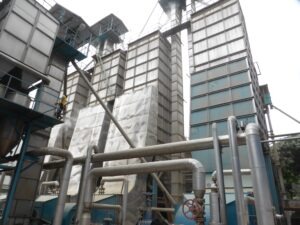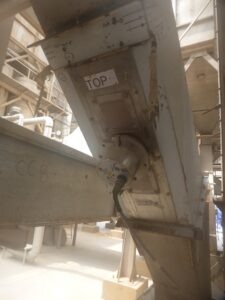Moisture Measurement in Rice Production
India is the second-largest producer of rice in the World, second only to China, and processing approximately 155.682 million metric tons per year. Its rice cultivation area covers more than 44 million hectares and accounts for 40% of the food production in the country. This article explores the benefits that introducing microwave moisture measurement into the drying process can bring to the producer.
If rice is going to be stored for a period of time then the preferred choice is paddy rice as this is the grain in its natural unprocessed state, still containing the husk. Ideally, this should have a moisture content of approximately 14% before storage. As a general “rule” the storage life of the grain is halved for every 1% increase in moisture content which means that accurate moisture measurement is vital to ensure profitability.
To increase the storage life of the grains and to preserve more of its nutritional value the rice is often steamed or parboiled in the husk before drying for storage or processing further. This gelatinizes the starch within the kernel and hardens the individual grains which make them easier to handle and also reduces the number of broken kernels during milling.
The processing of rice in India has typically been manual, relying on a workforce to turn the grains in the sun to dry them after steaming and before the rice is sent for milling or storage. Recent changes in dryer technologies have allowed larger processing plants to dry much larger quantities of rice. However, operators have still manually controlled the drying functions of these systems which can cause inefficient drying when the process is not fully understood.
The introduction of affordable digital microwave moisture measurement into the process is revolutionising the rice industry in India. It provides accurate moisture readings of the grain at important stages of the process enabling the producers to directly control the dryers in real-time. This leads to rice that has been dried to the correct moisture percentage for processing and has the direct effect of increasing the quality of the grains and therefore an increase in the producers’ profitability.
Parboiling Paddy Rice

The parboiling process consists of heating the rice in circulating hot water for up to 7-8 hours in boiling kettles or soaking tanks which typically hold between 1,000 and 2,000 litres each. The rice is at a moisture content of around 30% when it is discharged to a drying system.
Drying Rice
There are two main objectives when drying rice, the first is to minimise the amount of broken rice in the final product and the second is to get to the target moisture level as quickly and accurately as possible to reduce energy expenditure.
The rice is typically between 30-34% moisture when it enters the drying process after parboiling. It needs to be dried to reach a target of 14% before being passed across for storage or 10-12% for the milling process, where it is de-husked, sorted, and polished before packaging.
Drying systems may be either a batch or a continuous process. In a batch dryer, the rice is circulated until the moisture level reaches a set target. In a continuous dryer process the rice passes through a number of stages, often using different dryers, with each stage reducing the temperature of the dryer as the target moisture level is reached. This allows the rice to be dried quickly while the moisture level is higher and then more slowly as the rice gets drier. The end result is that the rice is dried as quickly as possible without affecting the quality of the final product.
The table below illustrates an example of the targets reached during this process:
| Stage No: | Set Moisture% | Set Temp °C | Fan Speed (Hz) |
| 1 | 18.0 | 100 | 55 |
| 2 | 16.0 | 105 | 50 |
| 3 | 14.0 | 100 | 50 |
| 4 | 11.90 | 90 | 55 |
Installing a Moisture Sensor

The installation of a proven microwave moisture sensor into the system will enable the producer to accurately know the moisture level of the rice at critical parts of the process enabling them to control the dryer temperature and drying time. In a batch dryer system, the best location for measuring moisture is in the outlet from the dryer where it goes to the elevator which either recirculates the rice or sends it forward to the milling hall.
In a multi-stage (continuous) dryer, the best results can be obtained by measuring at the outlet from each of the stages. This enables each stage to be individually controlled to get the correct moisture level before the rice is transferred to the next stage. The most effective measurement for either system is achieved using a moisture sensor that is mounted in ducting.
Calibration and Accuracy
Some sensor manufacturers sell their equipment with generic calibration constants for different materials or claim that calibration is not required, but this does not remove the need for the calibration process if a user wants to get the best results from their sensor. As an example of this, if the producer uses a generic value for the calibration constants an accuracy of +/-1% may be achieved. However, by using a full calibration technique it is possible to get a basic accuracy of +/-0.5% and, with the best care and testing, even achieve +/-0.3%. Therefore it is important to have a simple and effective way of performing a calibration.
Hydronix always recommends using real values from the process to define the calibration rather than generic values. This is usually done during the commissioning of the sensor so that the producer has accurate values to work with from the start and they should not need to recalibrate the sensor unless there is a distinct change in the material. However, it is simple to perform sensor calibrations if needed. The producer notes the reading from the sensor at the same time as taking a sample of the material. The material sample is then completely dried and analysed using the producers’ current method, for example, a moisture balance or desktop analyser. Using the sensor software the resulting values from both processes are entered into a table. Hydronix sensors respond linearly to changes in moisture so a minimum of only two test results are required in order for the sensor to derive the moisture percentage for all other values.
Sensors that use older technology, for example, those using analogue measurement techniques, do not have this linear relationship with the change in the moisture and this increases the work needed to define the relationship to the sensor value. These sensors are also more difficult to stabilise for environmental and manufacturing variations, which decreases the reliability and repeatability of the measurement.
Benefits of moisture measurement
In a batch dryer system, the automation control system would have the temperature set-points adjusted periodically to match each stage of the process. This was usually done manually by an operator using either an offline moisture tester to test a sample of rice or by the look and feel of the rice grains. By installing moisture measurement sensors, it is possible to automatically adjust the control loop set-points in real-time to match the drying stage of the rice.
This automatic adjustment provides a major cost-saving by reducing the amount of energy required to heat the dryers as the rice is automatically dried at the optimum rate for that stage of the process. This will also result in a final product quality improvement as there is less breakage due to the grains being dried too quickly.
A Hydronix customer, MJ Grain Products PVT LTD of Siliguri in India, has reported
“before installing moisture measurement we were experiencing a 5% loss due to broken or cracked rice. This has been reduced to 1.3% after installing 4 Hydronix moisture sensors into our process. This gives us an increased yield of 3.7% and the sensors have paid us back for the capital outlay very quickly”.

